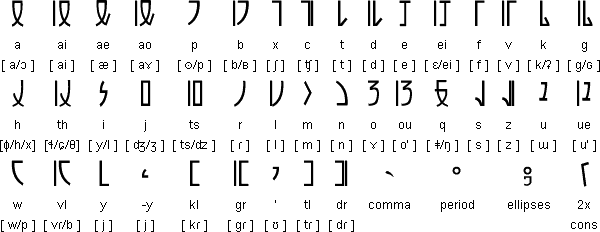Rirasu alphabet

The Rirasu alphabet was created by Samantha Phillips to
write her invented language, Vijyal. In Vijyal, “rirasu”
translates to “that which is written”. At first, old rirasu,
or “kla umi” was a CV syllabary, however the number of glyphs
required as well as the use of ending consonants caused this
syllabary to be abandoned. Rirasu was created as a way to
represent the sounds of Vijyal with as few glyphs as possible.
Each glyph is assigned to one or a set of sounds. For example,
“t” has only one sound, [t], while “h” has three sounds [ɸ],
[h], and [x], and “a” changes from [a] to [ɔ]. This
occurs because of sound change within the language itself.

Notes
- “a” represents the [a] at the beginning of words that is always
changed to [ɔ] at the middle and ends of words. - “h” is [ɸ] as a beginning consonant, [h] as a consonant
beginning a consonant vowel pair in the middle of a word, and [x]
as a solo consonant at the end of a syllable or word. - In other cases where a letter has more than one pronunciation,
the first is used at the beginnings of words and the second elsewhere. - The final symbol in the chart above causes the consonant after
it to become doubled.
Sample text in Vijyal language and Rirasu alphabet

Transliteration
Tsuber mei ae ith mizaen an lora ue eidra an memuq’ ne-ira.
Reiso an feixya mi docete, an ka’m ei suila no enix mi sudi.
Translation
All human beings are born free and equal in dignity and rights. They
are endowed with reason and conscience and should act towards one another
in a spirit of brotherhood.
(Article 1 of the Universal Declaration of Human Rights)
